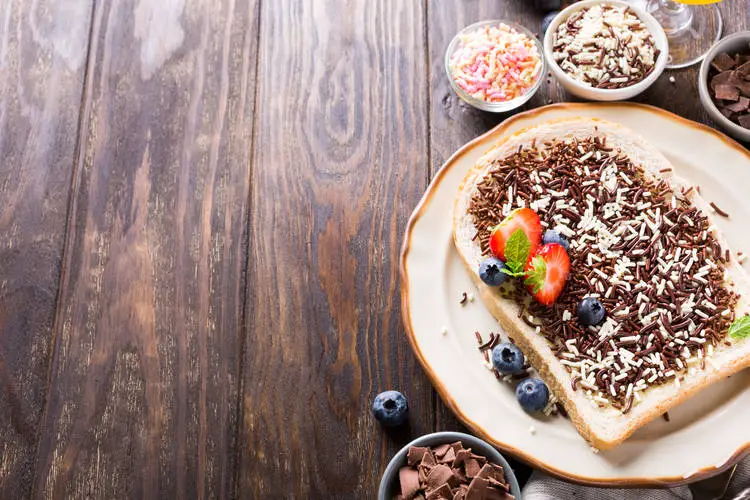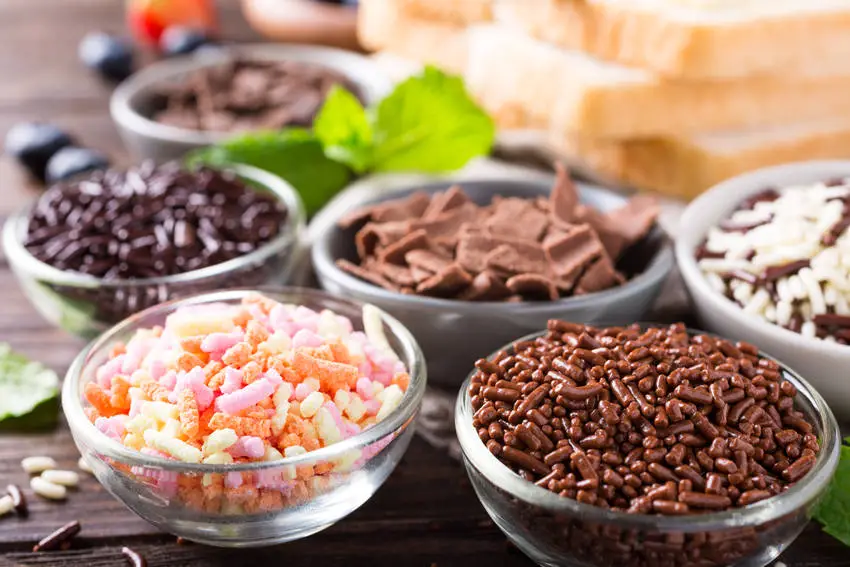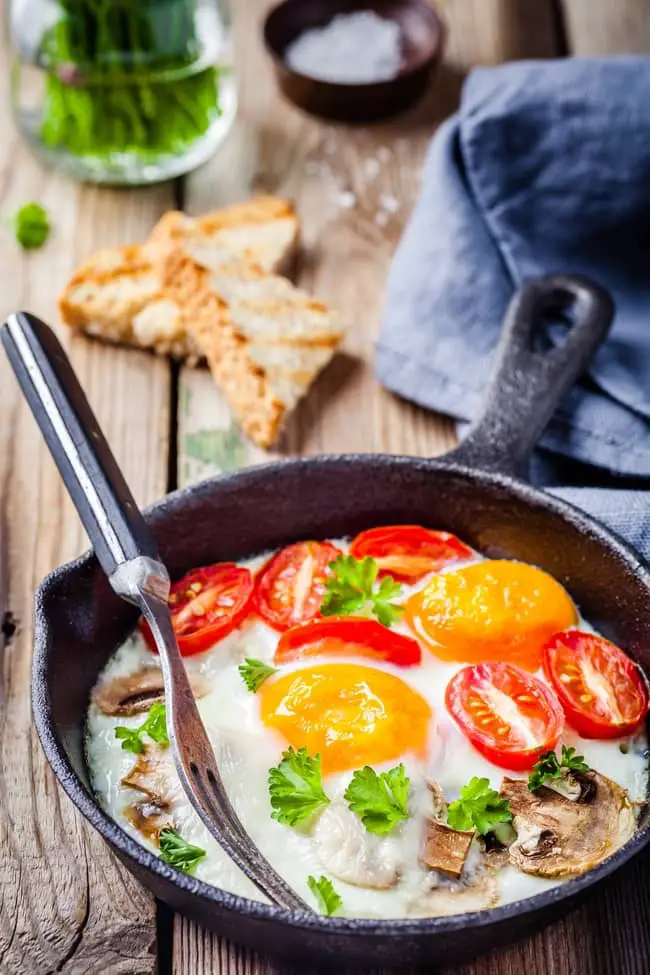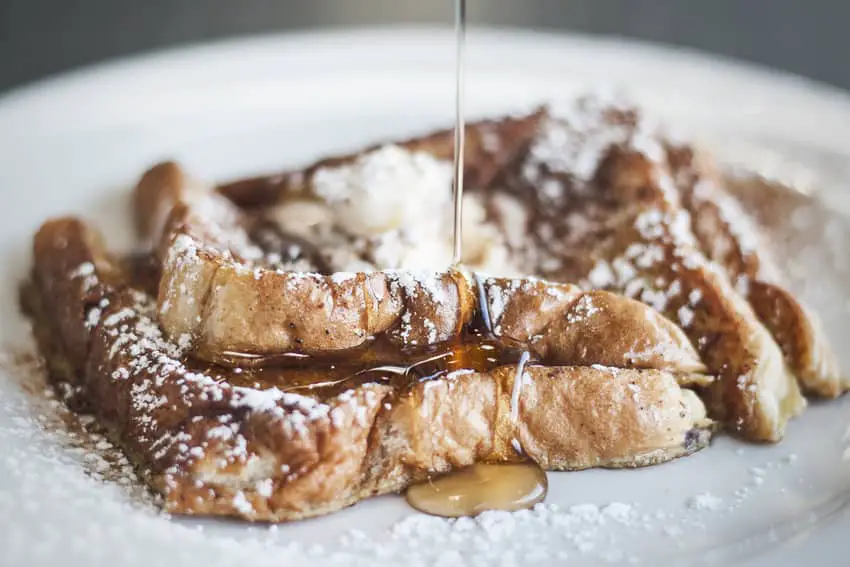Dutch cuisine is usually considered to be one of the worst in the world. That’s a fact. It, of course, includes some popular ingredients, plenty of bread, fruit and dairy, but in general, all traditional Dutch meals are at least weird for foreigners. Maybe it’s because Dutch cuisine is varied because of the influences of many different countries and cultures? Anyway, there are some breakfast foods you should definitely try while visiting the Netherlands and most of them aren’t usually found on tables elsewhere. So, would you like to try eating like a Dutch for a day or two? I have dived deeply into some traditional Dutch recipes to find the most interesting Dutch breakfast foods. I’m wondering if you’ll love the following eight dishes or maybe you’ll hate them. Anyway, they are worth trying:
- Hagelslag
- Ontbijtkoek
- Bacon and apple pancakes
- Volkorenbrood – Dutch whole wheat bread
- Uitsmijter
- Wentelteefjes
- Omelet with turnip greens, goat’s cheese and chili
- Boterham
So, if you are a fan of toppings, cold meats, buttered bread and cheese, there’s a chance you will love Dutch breakfasts. Go through the article to get some more details on the dishes above!
1. Hagelslag
This is one of the most famous Dutch breakfast foods. At first sight, it looks absolutely weird for a foreign visitor. We all remember times when sprinkles made ice cream even more delicious long time ago, but chocolate sprinkles on bread? Bleh! However, in the Netherlands sprinkles are not reserved for kids – hagelslag is loved by Dutch – young and old ones.

Even if such type of sprinkles is usually reserved for cakes in most countries, Dutch people serve it on top of buttered bread for breakfast. To be honest, when I have first seen grown-ups eating chocolate sprinkles on their toast, I was more than shocked.
Hmm, as according to some serious research, the Netherlands is among the six happiest countries in the world, maybe chocolate sprinkles have something to do with this?
Where Does Hagelslag Come From?
Hagelslag is believed to come from Amsterdam. It was invented by the director of candy manufacturer in Jordaan – B. E. Dieperink – in 1919. The first hagelslag was anise-flavoured and crispy. Around 10 years later some new flavours (lemon, orange, raspberry) were invented by another candy manufacturer – DeRuijter. Originally, they were nicely packed in paper cones.
What Is Hagelslag Actually?
The Dutch word ‘hagel’ literally means ‘hail’ so I believe that the author had a hailstorm of chocolate on their mind. Hagelslag is a sandwich with sprinkles – usually the chocolate one (‘chocolade hagelslag’) but sometimes also with anise seed or fruit (like strawberry) or vanilla.

Sometimes sprinkles are in the form of chocolate shavings, made of either milk or white chocolate. You can even buy them ready-to-eat at most supermarkets sold by the carton. Cartons have retractable spouts so all you have to do in order to have a typical Dutch breakfast is pour it onto your sandwich. Might look really surprising at the beginning but hey, it tastes really good!
2. Ontbijtkoek
Literally, ‘ontbijkoek’ can be translated as ‘breakfast cake’ (how surprising, huh?). It’s a very popular Dutch spiced cake. Originally, the cake was made from breadcrumbs and other left-over bakery products in almost all parts of Holland. It was mostly eaten in northern parts of the country. Nowadays, it has become a bit less common, but you can still find it in most supermarkets and bakeries (there are several brands famous for their ontbijtkoek like Snelle-Jelle).

The cake tastes best baked from scratch at home, though. Many Dutch people I know consider ontbijtkoek to be an integral part of their breakfast table. In traditional Dutch households you will often find some special tin canisters to keep ontbijtkoek in. This way, the loaf of cake is fresh longer. Why special canister? The cake is traditionally long shaped, quite big and squared off.
What Does It Taste Like?
For me, a foreigner, ontbijtkoek is like a bit heavier version of ginger cake. The most important ingredient of ontbijkoek is rye flour (this is why the colour is light brown). You can also add dried fruit, raisins, nuts, candied ginger and sugar there.

The cake is spiced with cinnamon, ginger, nutmeg, succade, cloves etc. Some people eat their breakfast ontbijtkoek with a spread of butter or topped with cream cheese. Even if the cake is a typical Dutch breakfast, I definitely prefer to have it as an afternoon snack with a cup of coffee.
How to Prepare Ontbijkoek?
Ontbijkoek isn’t the most difficult cake in the world. It doesn’t take much time to prepare your own Dutch spiced cake (however, be aware that the cake has to ‘wait’ for a day in order to get dry). You just need to mix all ingredients (whole wheat flour, baking powder, salt, brown sugar, molasses, almond milk, cloves, cinnamon, nutmeg, ginger) with an electric mixer.
Put the batter into a cake pan coated with coconut oil. Bake one hour and the cool in the pan around 30 minutes. The cake should be then wrapped with aluminum foil for approximately 24 hours. And that’s it. After a day your Dutch spiced cake is ready. And it tastes insanely good, especially with a cup of tea or, if you have a sweet tooth, a cup of cocoa.
3. Pancakes
Pancakes are one of the most popular breakfasts in the world. However, a traditional, sweet version of pancakes isn’t served as a breakfast in the Netherlands. It’s different with savory pancakes – this kind of meal is popular in the Netherlands, as well as in Canada. In Canada, pancakes are usually served with maple syrup and salty bacon.

However, Dutch people have made them even more interesting – the traditional pancakes are served with slices of apple, Dutch bacon (called ‘spek’ in Holland) and onion. Very often they are also poured with some dark apple spread (‘Rinse Apple Stroop’ – can be bought in most supermarkets).
There’s also a chance to choose the type of bacon you like – among the others you’ll find a thick sliced option, a peppered one, hickory smoked, honey maple etc. The varieties don’t end. There are also some variations on the ingredients you add – sometimes there’s also a handful of grated Gouda cheese on top.
Why Does a Combination of Bacon and Apple Taste So Good?
Dutch bacon and apple pancakes are plate-sized. They are both sweet, sour and savory (image the apple & bacon mix!). A dark molasses-like syrup makes the dish taste more unobviously as it’s very sweet which is surprising.

The greatest thing about bacon and apple pancakes served in Holland is that they are an amazing fusion of flavours – all in one they are salty, sweet and tart. Not everyone likes such combination but for sure this is something worth trying while in the Netherlands. And one more plus behind the famous bacon and apple pancakes is that they are just a perfect cure for… hangover.
4. Volkorenbrood – Dutch Whole Wheat Bread
You may be surprised but a traditional whole wheat bread is one of the foods the Netherlands is famous for. It’s been proved that the Dutch consume around 63 kilograms per capita each year. And approximately 75% of the Dutch population prefer whole wheat to white bread.

Very often volkorenbrood has been called ‘bruin brood’ which can be translated as ‘brown bread’. The bread itself looks quite interesting – there are two half loaves placed together side by side. If you’re looking for a nice Dutch artisan bakery that specialises in whole wheat baked goods, I have one you’ll like for sure – Hartog’s Volkoren Bakkerij & Maalderij in Amsterdam. Their bread is perfectly dense and hearty, definitely worth trying out! However, the traditional Dutch volkorenbrood is more than possible to prepare yourself. Even if you haven’t baked any bread in your life before.
Make It Yourself
It’s quite easy to make your own Dutch whole wheat bread. An old recipe is very simple and contains no improvers, sugars and additives (a traditional bread doesn’t even contain any additional grains). There are only the following ingredients: whole wheat flour, water, salt, olive oil and yeast (fresh yeast is a secret here!).
You proceed like with all the other bakeries – mix the ingredients, knead the dough, allow it to rise and bake in the oven for around 40 minutes. A good thing is that the bread is very filling, so a hearty loaf goes a very long way. You can add various toppings while serving bread for breakfast. These are for example grated cheese, peanut butter (especially the salty one tastes is amazing), cold meats, jam, honey or appelstroop.
5. Uitsmijter
Eggs might be considered the most popular breakfast ingredient in the whole world. And uitsmijter is a very common dish in the Netherlands. Literally it can be translated as ‘eject forcefully’ or a bouncer. The history behind it is connected with the past when the dish was served in cafes very late at night when some last guests were kindly asked by bouncers to leave at closing time. The dish was served to those bar-goers right before they were shown the door.

Uitsmijter is a kind of a large breakfast including bread, fried eggs, and ham. It’s not like a sandwich for dainty eaters or when you’re not insanely hungry. This is a dish to deal with a real hunger. Can you imagine yourself on the amazing canals in Amsterdam, grabbing a traditional fried egg and ham uitsmijter? Worth experiencing while in the Netherlands…
How to Prepare Uitsmijter
In order to prepare a traditional Dutch uitsmijter, you need the following ingredients: white bakery bread, a few slices of ham, over-easy fried eggs, some Gouda cheese (2-3 slices), butter, salt and pepper. You just put the fried eggs on top of a slice of bread and there you put some cheese to melt on. Then a slice of ham goes.

Of course, uitsmijter has many variations. Among the others it can be served with some extra items like salad, sliced tomatoes, cheese and other types of meat (sausage, bacon, pastrami, turkey etc.). Some people also add a little bit of Tabasco. The sandwich is usually eaten with knife and fork.
6. Wentelteefjes
From Europe to North America – everyone is familiar with French toast and most of you have tried them many times. This sweet bread dish is also common in the Netherlands – it’s called wentelteefjes (the first part of the word means ‘soaked’). The name itself often generates a smile from the adults as the word can be also translated as an insult (teef is a Dutch word a female dog).

For many foreigners and expats wentelteefjes are the favourite one among the traditional Dutch breakfast foods. You can find them in many Dutch restaurants but to be honest, they taste the most delicious when you make them yourself at home.
How to Prepare the French Toasts Dutch Way
In order to try Dutch wentelteefjes you need slices of day-old bread (you can also use slices of so-called suikerbrood which is a kind of some sweet bread) and a mixture of milk (approximately ¼ litre), 2 lightly beaten eggs and a little bit of salt. All you need to do is remove the crust from the bread and soak it in the mixture and then fry the bread slices on both sides in a buttered frying pan.

Once it’s done, sprinkle the toasts with sugar. Some people also add some cinnamon and it’s very common in the Netherlands to top wentelteefjes with a bit of jam or compote. Serve the toasts immediately! They taste best when you have time to sit down and enjoy your breakfast for a while with a cup of coffee.
7. Omelet with Turnip Greens, Goat’s Cheese and Chili
Another breakfast made of eggs. A Dutch name – boerenomelet – literally means ‘farmer’s omelet’ which is a mixed vegetable omelet. Full of dietary fiber, iron and vitamins (A, B, C, K), such omelet is a perfect start of the day.

On top of its amazing taste it has a very good nutritional profile which means it’s really healthy. The omelet tastes best served with a leafy green salad. As you can imagine, making an omelet is fairly quick and easy. It’s all about not browning the outside but rather caramelise it a bit and keep it a bit gooey inside.
How to Prepare Dutch Omelet?
All ingredients are easily available in Spring at health food stores. You’ll also find them in organic supermarkets and farmers markets. If you don’t find turnip greens, you can just replace them with a mixture of spinach and rocket. In addition to turnip greens you’ll also need 3 eggs, a little bit of cream and sunflower oil, butter, 1 chopped red chili and crumbled goat’s cheese.

Start with beating the eggs with the cream, then make the chili and turnip greens wilt in the buttered and oiled frying pan (if turnip greens are tough, you can blanch it in boiling water before using). Add the eggs, wait a while and add the cheese. Flip the omelet over and take it off from the heat. It should be ready after a minute.
8. Boterham

And then, last but not least, there’s famous Dutch boterham. A combination of butter and ham on bread. Not only is boterham a breakfast, it’s also one of the most popular Dutch lunch dishes. Believe me, you will see many Dutch people having their boterham wrapped in an aluminum foil on Amsterdam’s streets in the morning.
It’s filling and large, just perfect for those who need more energy for the rest of the afternoon, or sometimes the whole day. In short, a boterham is just a slice of bread or a folded slice of bread with filling. There are two types of boterham, depending on the number of slices: there’s an enkele boterham (a single slice of bread) and a dubbele boterham if there are two slices that look like a regular sandwich.
How Does a Boterham Look?
Sometimes the ham is replaced with cheese but there’s no option to have both the ham and cheese on bread. There are also some Dutch people who like it with liverworst or chocolate spread which is often quite weird for foreigners. The best thing about boterham is probably its simplicity.
In fact, in the Netherlands, it’s considered to be quite healthy food, great for people who need to have a quick breakfast while on the go. Even while riding a bike, which is a common habit among the Dutch.
Summary
It’s not very popular in the Netherlands to go out for breakfast. Most Dutch people just prepare their morning meal at home. Maybe this is one of the reasons why Dutch breakfast foods are such weird when it comes to combining the ingredients? I don’t know. Most Dutch breakfasts are made at home, they are simple and quick to prepare. Research shows that the average Dutch spends only several minutes preparing a dinner (daily) and it’s even less when it comes to breakfast. No other nation cooks as fast as Dutch. To be honest, to me that explains a lot. Still, there are some combinations you cannot miss out on trying while visiting the country. Ontbijtkoek or volkorenbrood – definitely to die for! Eet smakelijk then!